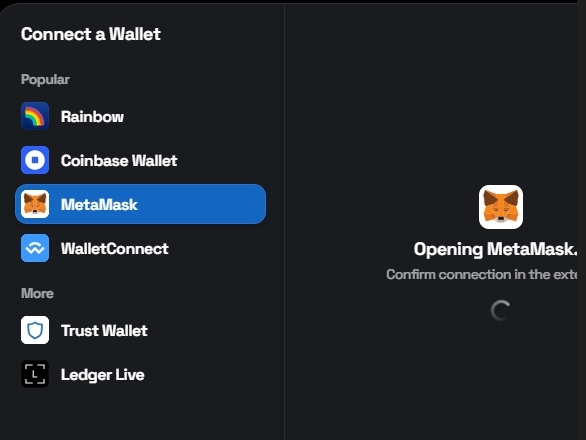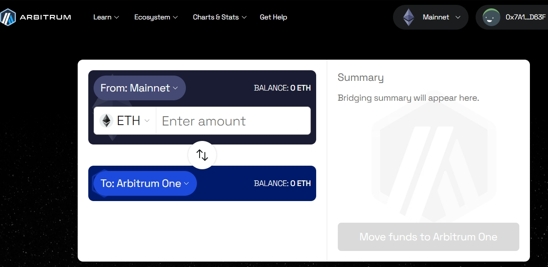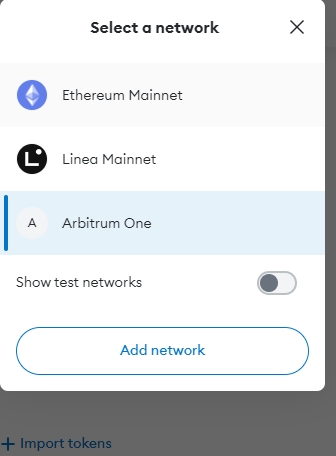Fiat currencies
Crypto Currencies
No results for ""
We couldn't find anything matching your search.Try again with a different term.
How To Bridge to Arbitrum: A Step-by-Step Guide for Ethereum Users
Are you looking for a way to scale your Ethereum transactions without compromising on security or decentralization? Do you want to enjoy lower fees, faster confirmations, and more possibilities on the Ethereum network? If so, you might be interested in learning how to bridge to Arbitrum, one of the most promising layer 2 scaling solutions for Ethereum.
Arbitrum is a technology suite that uses optimistic rollups to achieve its goal of improving speed, scalability, and cost-efficiency on Ethereum. Arbitrum benefits from the security and compatibility of Ethereum, but also offers higher throughput and lower fees compared to the main chain. Arbitrum also supports smart contracts, decentralized applications, and any programming language that compiles to EVM bytecode.
But how can you access Arbitrum and use its features? The answer is by bridging your assets from Ethereum to Arbitrum. Bridging is the process of transferring your tokens or NFTs from one blockchain to another. In this case, you will be moving your assets from the Ethereum layer 1 to the Arbitrum layer 2. This way, you can take advantage of the benefits of both chains without having to sell or swap your assets.
In this article, we will show you how to bridge to Arbitrum using the official Arbitrum Bridge portal. We will also explain some of the benefits and risks of bridging, and answer some frequently asked questions about Arbitrum. By the end of this article, you should have a clear understanding of how to bridge to Arbitrum and why you might want to do so.
What are the benefits of bridging to Arbitrum?
Bridging to Arbitrum has several benefits for Ethereum users, such as:
- Lower fees: Arbitrum transactions are much cheaper than Ethereum transactions, as they only incur a small fraction of the gas costs. According to Arbitrum’s website, the average transaction fee on Arbitrum is about $0.01, compared to $10-$20 on Ethereum.
- Faster confirmations: Arbitrum transactions are confirmed almost instantly, as they only need to be validated by the Arbitrum validators. On Ethereum, transactions need to wait for multiple block confirmations, which can take several minutes or hours depending on the network congestion.
- More possibilities: Arbitrum supports any smart contract or decentralized application that runs on Ethereum, with no code changes required. This means that you can use your favorite dapps on Arbitrum without any hassle. Moreover, Arbitrum enables new possibilities that are not feasible on Ethereum due to its scalability limitations, such as complex gaming and social applications.
What are the risks of bridging to Arbitrum?
Bridging to Arbitrum also has some risks that you should be aware of before proceeding, such as:
- Locking period: When you bridge your assets from Ethereum to Arbitrum, they will be locked on the Ethereum chain until they are unlocked on the Arbitrum chain. This process can take up to 10 minutes, depending on the network conditions. Similarly, when you bridge your assets back from Arbitrum to Ethereum, they will be locked on the Arbitrum chain until they are unlocked on the Ethereum chain. This process can take up to one week, as it involves a fraud-proof challenge period. During these locking periods, you will not be able to access or use your assets on either chain.
- Liquidity issues: When you bridge your assets to Arbitrum, you will need to use them on the Arbitrum chain or bridge them back to Ethereum. You cannot directly trade or swap them with other users or platforms that are not compatible with Arbitrum. This means that you might face liquidity issues if there is not enough demand or supply for your assets on the Arbitrum chain. You might also face price discrepancies between the two chains due to different market conditions.
- Security trade-offs: While Arbitrum inherits the security of Ethereum, it also introduces some trade-offs that might affect its security guarantees. For example, Arbitrum relies on a set of validators that are responsible for executing and validating transactions on the layer 2 chain. These validators are incentivized by fees and penalties, but they might also collude or act maliciously in some scenarios. Moreover, Arbitrum uses optimistic rollups, which assume that transactions are valid unless proven otherwise. This means that invalid transactions might be temporarily accepted until they are challenged and reverted by honest users or validators.
How to bridge to Arbitrum using the official portal?
Now that you know the benefits and risks of bridging to Arbitrum, let’s see how you can actually do it using the official portal provided by Offchain Labs, the developers behind Arbitrum.
To bridge your assets from Ethereum to Arbitrum using the portal, you will need:
- A web3-enabled browser or wallet that supports Ethereum and Arbitrum networks, such as MetaMask, WalletConnect, Coinbase Wallet, or Ledger.
- Some ETH and ERC-20 tokens or NFTs that you want to bridge to Arbitrum. You will also need some ETH to pay for the gas fees on the Ethereum chain.
- Access to the Arbitrum Bridge portal, which is the official interface for bridging assets between Ethereum and Arbitrum.
Once you have these requirements, you can follow these steps to bridge your assets to Arbitrum:
Connect your web3-enabled browser or wallet to the Arbitrum Bridge portal. You will see a screen like this:

Select the network that you want to bridge from. In this case, you will select Ethereum as the source network and Arbitrum One as the destination network. You will see a screen like this:

Select the asset that you want to bridge. You can choose from ETH, ERC-20 tokens, or NFTs.
Enter the amount or ID of the asset that you want to bridge. You can also use the max button to bridge all your available balance of that asset.
Review the details of your bridging transaction and click on "Bridge Asset". Confirm the transaction on your web3-enabled browser or wallet. You will need to pay some gas fees on the Ethereum chain for this transaction.
Wait for the transaction to be confirmed on the Ethereum chain and then unlocked on the Arbitrum chain. This can take up to 10 minutes, depending on the network conditions.
Congratulations, you have successfully bridged your asset from Ethereum to Arbitrum! You can now use it on the Arbitrum chain or bridge it back to Ethereum whenever you want.
What are the fees for bridging to Arbitrum?
The fees for bridging to Arbitrum consist of two parts: the gas fees on the Ethereum chain and the bridge fees on the Arbitrum chain.
The gas fees on the Ethereum chain depend on the network congestion and the complexity of your transaction. You can check the current gas prices on [ETH Gas Station] or [Gas Now]. The gas fees are paid in ETH and go to the Ethereum miners.
The bridge fees on the Arbitrum chain depend on the amount and type of asset that you are bridging. The bridge fees are paid in ETH and go to the Arbitrum validators.
According to Arbitrum’s website, the bridge fees are calculated as follows:
- For ETH: 0.05% of the amount bridged
- For ERC-20 tokens: 0.1% of the amount bridged
- For NFTs: 0.01 ETH per NFT
You can check the current bridge fees on the portal before confirming your transaction.
How long does it take to bridge to Arbitrum?
The time it takes to bridge to Arbitrum depends on two factors: the confirmation time on the Ethereum chain and the unlocking time on the Arbitrum chain.
The confirmation time on the Ethereum chain depends on the network congestion and the gas price that you set for your transaction. The higher the gas price, the faster your transaction will be confirmed by the Ethereum miners. The confirmation time can vary from a few seconds to several minutes or hours.
The unlocking time on the Arbitrum chain depends on how often the Arbitrum validators post batches of transactions to the Ethereum chain. The more frequently they post batches, the faster your transaction will be unlocked by the Arbitrum validators. The unlocking time can vary from a few seconds to 10 minutes.
According to Arbitrum’s website, you can expect your bridging transaction to be completed within 10 minutes in most cases.
How do I switch networks from Ethereum to Arbitrum?
To switch networks from Ethereum to Arbitrum, you will need to add Arbitrum as a custom network on your web3-enabled browser or wallet.
Once you have added Arbitrum as a custom network, you can switch between Ethereum and Arbitrum by selecting the network from the dropdown menu on your web3-enabled browser or wallet. You will see a screen like this:

How do I bridge back from Arbitrum to Ethereum?
To bridge back from Arbitrum to Ethereum, you will need to follow the same steps as bridging to Arbitrum, but in reverse order. You will need to:
- Connect your web3-enabled browser or wallet to the Arbitrum Bridge portal and select Arbitrum as the source network and Ethereum as the destination network.
- Select the asset that you want to bridge back and enter the amount or ID of the asset that you want to bridge back.
- Review the details of your bridging transaction and click on "Bridge Asset".
- Confirm the transaction on your web3-enabled browser or wallet. You will need to pay some gas fees on the Arbitrum chain for this transaction.
- Wait for the transaction to be confirmed on the Arbitrum chain and then unlocked on the Ethereum chain. This can take up to one week, as it involves a fraud-proof challenge period.
Conclusion
In this article, we have shown you how to bridge to Arbitrum using the official portal. We have also explained some of the benefits and risks of bridging, and answered some frequently asked questions about Arbitrum. We hope that this article has helped you understand how to bridge to Arbitrum and why you might want to do so.
Bridging to Arbitrum is a great way to scale your Ethereum transactions without compromising on security or decentralization. By bridging your assets to Arbitrum, you can enjoy lower fees, faster confirmations, and more possibilities on the Ethereum network. You can also use your favorite dapps on Arbitrum without any hassle.
However, bridging to Arbitrum also has some risks that you should be aware of before proceeding, such as locking periods, liquidity issues, and security trade-offs. You should always do your own research and exercise caution when bridging your assets between different chains.
If you have any questions or feedback about this article, please feel free to talk on the CoinCarp community.
Stay tuned to CoinCarp Social Media and Discuss with Us:
$30,000 Deposit Blast-Off
Sponsored
Earn up to $30,000 when you make your first deposit and trade on Bybit! Register Now!